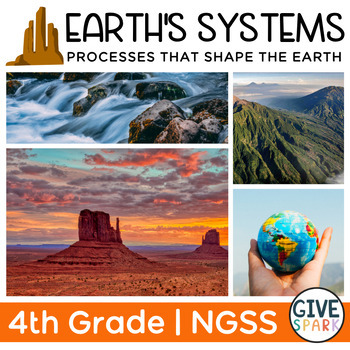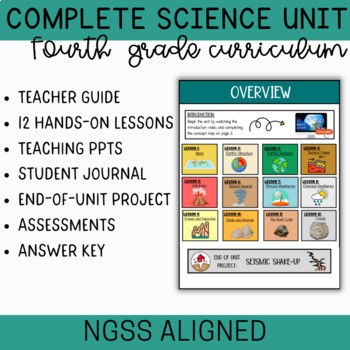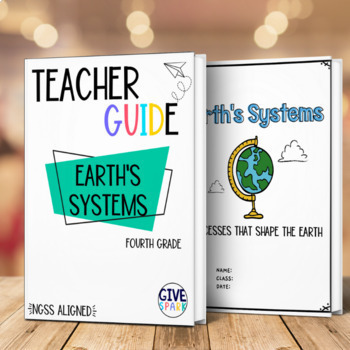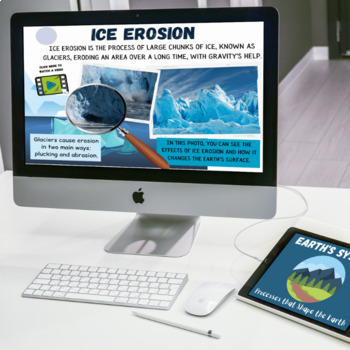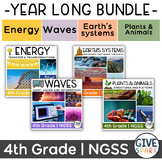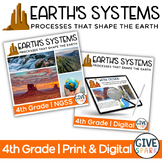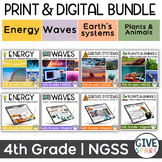4th Grade - Earth's Systems - Complete Comprehensive NGSS Science Unit
- Zip
- Easel Assessment
What educators are saying
Also included in
- 4th Grade Science Bundle - NGSS - Four Complete Units - Entire YearWelcome to the ultimate science teaching solution for 4th grade educators - the 4th Grade Science Super Bundle. This all-inclusive package is specially designed to ignite curiosity, enhance understanding, and fuel the passion for scPrice $53.00Original Price $63.80Save $10.80
- PRINT and DIGITAL - Earth's Systems - Changing Surface - Fourth Grade - NGSSThis comprehensive bundle unit is specifically designed for fourth-grade students to learn about the topic of Earth's Systems and Processes that Shape the Earth.STANDARDS ALIGNMENT:The unit consists of 12 engaging lessons fuPrice $22.50Original Price $28.95Save $6.45
- Fourth Grade NGSS: The Ultimate Teaching Bundle – Print & Digital!Get ready for an exciting teaching journey with this all-in-one bundle, perfect for fourth-grade teachers. This package includes FOUR highly engaging science units, all aligned with the NGSS standards. In this package, you will rePrice $85.00Original Price $115.80Save $30.80
Description
Earth's Changing Surface - Processes that Shape the Earth
This is a complete science curriculum specifically for teaching the topic of Earth's Systems. It is fully aligned with the Fourth grade NGSS standards.
--------------------APPROACH TO LEARNING---------------------
Unlock your students' natural curiosity and passion for science with this interactive and hands-on teaching unit. Designed to connect with their prior knowledge and provide immersive experiences, this unit offers lessons that guide students through complex scientific principles in an accessible way. Students will actively participate in hands-on experiments and activities that make learning exciting and memorable. This unit promotes independent learning and encourages students to reflect on their understanding, helping them build a solid foundation of knowledge in a fun and stimulating environment.
--------------------WHAT'S COVERED?---------------------
In this unit we look at the following topics:
- Maps
- Earth’s Structure
- Earth’s Systems
- Tectonic Plates
- Volcanoes
- Natural Hazards
- Physical Weathering
- Chemical Weathering
- Erosion and Deposition
- Rocks and Minerals
- The Rock Cycle
- Fossils
--------------------End of Unit Project---------------------
End of Unit Project: "SEISMIC SHAKE-UP" {see video intro here}
"At the conclusion of the unit, students collaborate on a hands-on project that brings their learning to life. In the 'Seismic Shakeup' challenge, they embark on a mission to design a building resistant to earthquakes, drawing upon principles of engineering and architecture. They'll grapple with the central question: 'How do structures withstand powerful forces?' Through teamwork and brainstorming, they'll conceptualize and construct their own earthquake-resistant structures.
--------------------WHAT'S INCLUDED?---------------------
- Engaging Lessons: This unit has 12 core lessons that are designed to connect with students' prior knowledge and guide them through complex scientific principles in an accessible way.
- Comprehensive Teaching Resources: For each unit, you'll receive teaching presentations in both PowerPoint and Google Slides formats, a detailed teacher's guide, an interactive student science journal, and more.
- End-of-Unit Project: Students use the engineering and design process to design and construct earthquake-resistant structures.
- Reading Tasks and Comprehension Activities: A range of read-and-response activities are included to enhance reading comprehension skills and understanding of scientific concepts.
- Hands-on Labs - A range of engaging labs that invite children to explore and learn through genuine inquiry and discovery.
- Vocabulary Posters: Key vocabulary terms are reinforced with visually appealing posters to aid retention and understanding.
- Formative and Summative Assessments: Gauge your students' progress with various comprehension tasks, quizzes, and reflection/journal prompts.
- Answer Keys: Save time on marking with included answer keys or model answers.
This unit offers an all-encompassing resource, providing everything you need to deliver engaging and effective science lessons throughout the entire academic year.
For a detailed look at each unit, please download the individual preview.
Customer Support:
- Email me at givesparkco@gmail.com
- submit a help ticket
- ask a question on the Q& A tab
Thank you for stopping by!
Best regards,
Vicky x
If you would like to get updates on NEW and CURRENT resources...
►FOLLOW me on Teachers Pay Teachers!
TERMS OF USE - © Give Spark, Inc.™
This item is a paid digital download from my TpT store.As such, it is for use in one classroom only. This item is also bound by copyright laws. Redistributing, editing, selling, or posting this item (or any part thereof) on the Internet are all strictly prohibited without first gaining permission from the author. Violations are subject to the penalties of the Digital Millennium Copyright Act. Please contact me if you wish to be granted special permissions.

